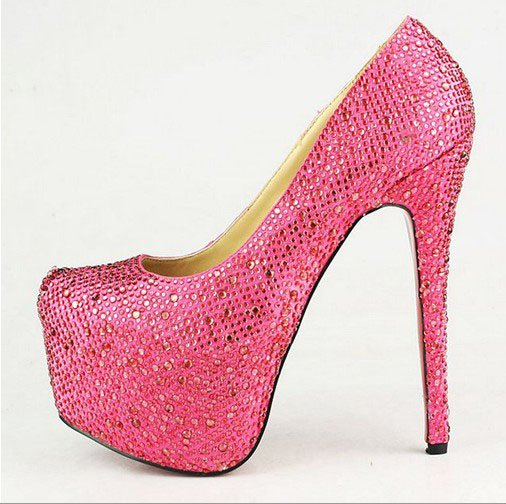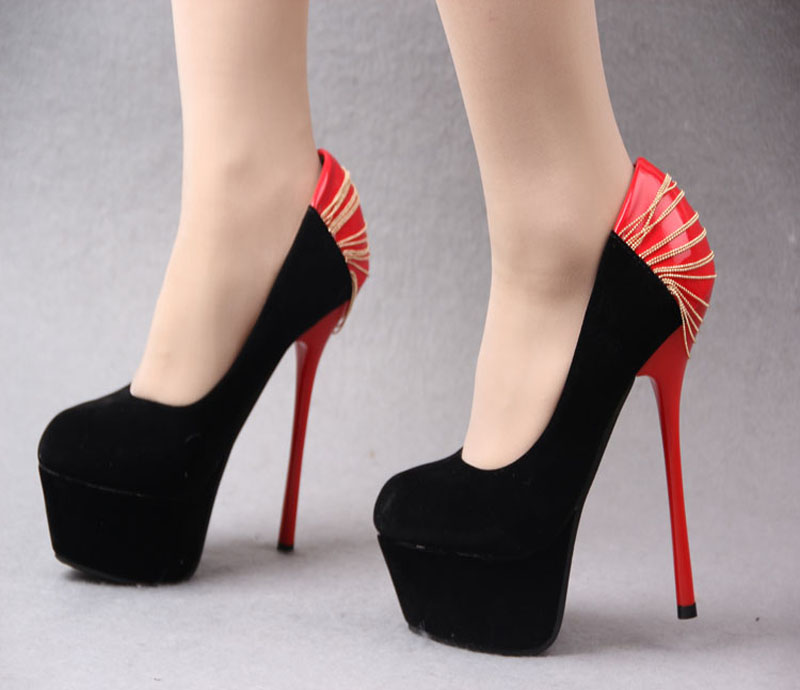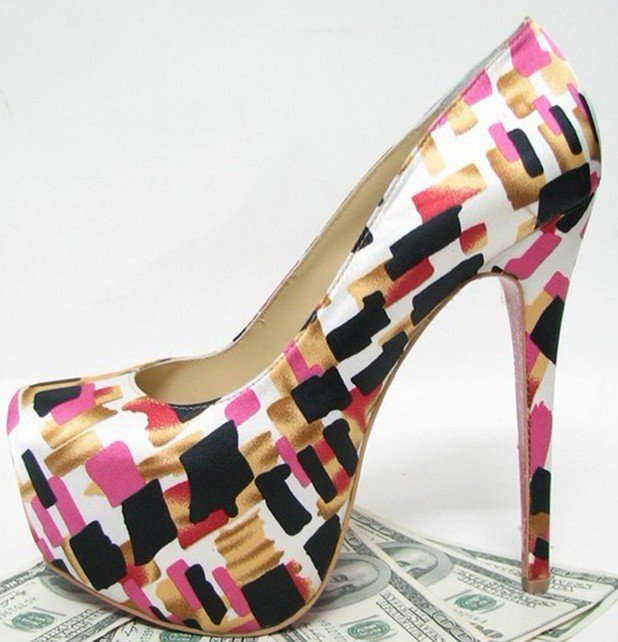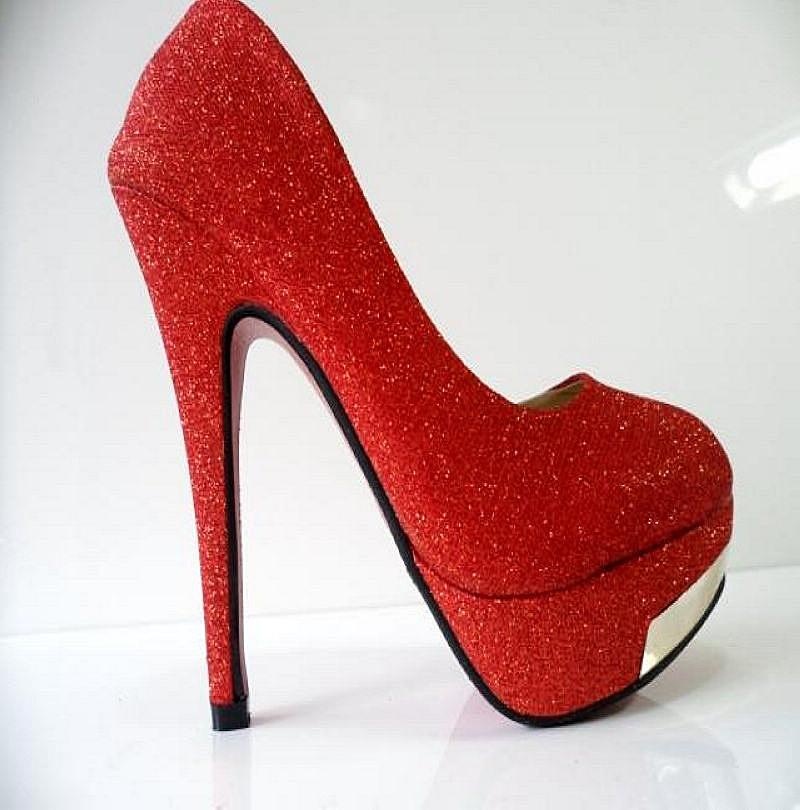High Heel Shoes Biography
Source (google.com.pk )The high-heeled shoe, or a shoe whose heel is higher than the toe, is a matter of contentious and heated discussion. Shoes in general have typically served as markers of gender, class, race, and ethnicity--and both the foot and the shoe have been imbued with powerful phallic and fertility symbols as evidenced in the contemporary practice of tying shoes to a newlywed couple’s car. No other shoe, however, has gestured toward leisure, sexuality, and sophistication as much as the high-heeled shoe. Fraught with contradiction, heels paradoxically inhibit movement in order to increase it, at least in appearance. Standing in heels, a woman presents herself already half-walking while at the same time reducing the length of her step, fostering the illusion of speed while suggesting the promise of an imminent fall. The higher and more unstable the heel, the more clearly these contradictions are expressed (Kunzle 2004). Doctors and scholars alike have argued about the physical and cultural effect, both positive and negative, that heels have had not only on women, but on society as a whole.
Precursors to the High-Heeled Shoe
Most of the lower class in ancient Egypt walked barefoot, but figures on murals dating from 3500 B.C. depict an early version of shoes worn mostly by the higher classes. These were leather pieces held together with lacing that was often arranged to look like the symbol of “Ankh,” which represents life. But there are also some depictions of both upper-class males and females wearing heels, probably for ceremonial purposes. Egyptian butchers also wore heels, to help them walk above the blood of dead beasts. In ancient Greece and Rome, platform sandals called kothorni, later known as buskins in the Renaissance, were shoes with high wood or cork soles that were popular particularly among actors who would wear shoes of different heights to indicated varying social status or importance of characters. In ancient Rome, sex trade was not illegal and female prostitutes were readily identified by their high heels (Wilson 2005).
chopines
Chopines, or platform shoes, were created in Turkey in the 1400s, and were popular throughout Europe until the mid-1600s
During the Middle Ages, both men and women would wear pattens, or wooden soles, that were clearly a precursor the high heel. Pattens would attach to fragile and expensive shoes to keep them out of the mud and other street “debris” when walking outdoors (Swann 1984). In the 1400s, chopines, or platform shoes, were created in Turkey and were popular throughout Europe until the mid-1600s. Chopines could be seven to eight or even 30 inches high, requiring women to use canes or servants to help them walk. Like pattens, chopines were overshoes, but unlike the pattens, chopines were worn almost exclusively by women (Rexford 2000). They were usually designed with cork or wood stacked as the heel.
The Venetians made the chopine into a status symbol revealing wealth and social standing for women, and tourists to Venice often remarked humorously on the outrageously high chopines. One visitor noted that they were “invented by husbands who hoped the cumbersome movement [that] entailed would make illicit liaisons difficult” (McDowell 1989). Already we can see issues of domination and submission being associated with shoes much like the lotus shoes of China. Indeed, Chinese concubines and Turkish odalisques wore high shoes, prompting scholars to speculate if heels were used not only for aesthetic reasons but also to prevent women from escaping the harem (Kunzle 2004).
Shoes were beginning to be made in two pieces during the 1500s, with a flexible upper attached to a heavier, stiffer sole (Swann 1984). This new two-part shoe led to the heel as an actual part of the shoe rather than just an attachable overshoe. Heels grew in popularity during the 1500s to keep riders, both male and female, from slipping from the stirrups. The “rider’s heel” was initially 1 to 1-½ inches high and resembled the modern riding boot and cowboy boot. The simple riding heel soon gave way to more stylized heels that were higher and thinner in the mid 1500s after Catherine de Medici made them more fashionable than functional.. The introduction of the high heel and the concomitant difficulty of making mirror image lasts (a foot mold used to make shoes) led shoemakers to create “straight shoes” or shoes that could fit either the left or right foot (Mitchell 1997). Right and left shoes would eventually return in the early1800s when high heels were abandoned (Swann 1984).
Formal Invention of High Heels as Fashion
The formal invention of high heels as fashion is typically attributed to the rather short-statured Catherine de Medici (1519-1589). At the age of 14, Catherine de Medici was engaged to the powerful Duke of Orleans, later the King of France. She was small (not quite five feet) relative to the Duke and hardly considered a beauty. She felt insecure in the arranged marriage knowing she would be the Queen of the French Court and in competition with the Duke’s favorite (and significantly taller) mistress, Diane de Poitiers. Looking for a way to dazzle the French nation and compensate for her perceived lack of aesthetic appeal, she donned heels two inches high that gave her a more towering physique and an alluring sway when she walked. Her heels were a wild success and soon high heels were associated with privilege. Mary Tudor, or “Bloody Mary,” another monarch seeking to appear larger than life, wore heels as high possible (McDowell 1989). By 1580, fashionable heels were popular for both sexes, and a person who had authority or wealth was often referred to as “well-heeled.”
King Louis XIV
In the early 1700s, France's King Louis XIV decreed that only nobility could wear heels that were colored red and that no one's heels could be higher than his own
In the early 1700s, France's King Louis XIV (The Sun King) would often wear intricate heels decorated with miniature battle scenes. Called “Louis heels,” they were often as tall as five inches. The king decreed that only nobility could wear heels that were colored red (les talons rogue) and that no one's heels could be higher than his own.. During the course of the century, a cultural kind of foot fetishism manifested itself in various media. For example, under the influence of rococo, a court-based decorative and ornamental style, heels became higher and more slender, a move that complemented the highly feminine court style. In addition, novelist Restif de Bretonne threw erotic emphasis on the finely arched foot and the delicately curved high heel (Kunzle 2004). Consequently, many women taped their feet to reduce their apparent size. Like the corset, high heels sculpted the body to make it appear more aristocratic, pure, refined, and desirable. The desirable and sexual nature of the high heel was also noted by the Puritans in the New World. The Massachusetts Colony even passed a law banning women from wearing high heels to ensnare a man or they would be tried as a witch (Murstein 1974). It wouldn’t be until the mid 1800s when American would catch up to Europe shoe fashion.
French Revolution and the Revolt against High Heels
In 1791, the “Louis” high heels disappeared with the revolution, and Napoleon banished high heels in an attempt to show equality. Despite the Napoleonic Code against high heels, in 1793 Marie Antoinette went to the scaffold to be executed wearing two-inch heels. The heel lowered greatly in the 1790s until it was reduced to the merest wedge or replaced by a spring heel, which was a single layer of leather inserted just above the sole at the back of the shoe. These flimsy shoes were often worn with ribbons to cross and tie around the ankle, reminiscent of the classical Roman sandal. The demise of the heel made it easier for shoes to be made for left and right feet, making them more comfortable. From this period to the 1930s, there were four major types of heels used on Western woman’s shoes: the knock-on, stacked, spring, and the re-emergence of the Louis (Rexford 2000).
High-Heeled Shoes Rise Again
In the 1860s, heels as fashion became popular again, and the invention of the sewing machine allowed greater variety in high heels. In Victorian art and literature, cartoons and allusions to tiny feet and the affliction of large feet (typical of the elderly spinster) were ubiquitous. Victorians thought that the high heel emphasized the instep arch, which was seen as symbolic of a curve of a woman. The high instep was also seen as preeminently aristocratic and European, while the “lowest type of foot,” that of the African American, had little or no instep. When high heels made their comeback, some wearers were comfortable in five- or even six-inch heels. As with corsets, high heels were claimed to be not only harmless, but beneficial to the health because, as advertisers stated, high heels helped alleviate backaches and stooping and made walking less tiring. But critics cited that high heels created a more sexually aggressive gait and compared the high heel to a “poisoned hook” to catch an unwary male. Some even associated the high heel with the cloven hoof of a devil or a witch. Cautionary tales from this time, such as many versions of Cinderella, concerned themselves with foot fetishism and warnings against fashionable foot compression (Kunzle 20004). Even with this criticism, America opened its first heel factory in 1888. However, America and other European countries still largely imitated French shoe fashion.
Twentieth-Century Heel Roller Coaster
While high heels enjoyed widespread popularity in the late nineteenth century, early twentieth-century women demanded more comfortable, flat-soled shoes-- that is until the roaring twenties when higher hemlines encouraged visible, elaborate, high, slender Louis heels. The Depression during the 1930s influenced Western shoe fashion as heels became lower and wider. Hollywood, however, gave the new heel an elegant look and stars’ shoes like Ginger Roger’s white and glittery heels began to challenge the influence of French shoe fashion in the West (Turim).. In the 1940s, luxury items were in short supply due to WWII and high heels tended to stay moderately high and thick.
The revival of Western high fashion in the post-war 1950s was led by French designer Christian Dior and his collaboration with shoe designer Roger Vivier. Together they developed a low-cut vamp (the portion of the shoe that covers the toe and instep) Louis shoe with a narrow heel called a stiletto, which is the Italian word for a small dagger with a slender, tapering blade (West 1993). First mentioned in London's Daily Telegram on September 10, 1953, the exaggeratedly slender heel and narrowing of the toe equated sheer height with chic and strongly suggested phallic-erectile symbolism and sexual maturation. Stilettos were often banned from public buildings because they caused physical damage to the floors (West 1993).
stilettos
"Stiletto" is the Italian word for a small dagger with a slender, tapering blade
With the creation of the miniskirt in the early 1960s, stilettos were attached to boots that enhanced the look of bare legs. As the feminist movement gained momentum, however, stilettos went out of favor with the cry: “Liberate the captive foot of womanhood!” For many feminists, high heels indicated subservience and sexual stereotyping by men. High heels were titillating “man-made” objects, literally involved in crippling women, or at least slowing them down when the need to run away from male violence and oppressors arose. Heels were seen as a comparable successor to foot binding and the tight-laced corset as perverse regulatory objects for molding the feminine. Consequently, heels dropped and thickened, and soon low-heeled shoes with square toes replaced the stiletto (Gamman 1993). Late 1960s disillusionment with contemporary life and anxiety about the future led young people throughout much of the West to embrace the hippie culture that revived the platform shoe.
Platform shoes became immensely popular in the 1970s, and perhaps no instance epitomizes the era like John Travolta’s Cuban-heeled platforms in the opening sequence of Saturday Night Fever in 1977. The 1970s in general were a tumultuous time of experimentation of drugs, sex and, of course, fashion. Cynicism abounded as various cultures and subcultures vied for public attention. Men as well as women would dress to shock, often wearing platform shoes reminiscent of the ancient kothorni and chopine with psychedelic swirls and colors.
In the post-modern context of the 1980s, the feminist rejection of fashion started to lose much of its grassroots support. The idea that fashion, specifically sexy shoes, were not simply oppressive but offered pleasure to women became more widely accepted (Gamman 1993). Critics, particularly feminists in the 1980s, argued that fashion can be an experiment with appearances, an experiment that challenges cultural meaning. This change of heart about high heels perhaps was provoked by counter-cultural street fashion of the early 1980s as well as by feminist debates about pleasure and female desire, which indirectly changed the way fashion was understood. Western women now claimed they were wearing high heels for themselves and that heels gave them not only height but also power and authority.
While lower heels were preferred during the late 60s and 70s, higher heels returned in the 1980s and early 1990s. Specifically, Manolo Blahnik’s high-heeled shoes were seen everywhere on the catwalks as new designers started to rethink high heels. As opulent television shows such as Dallas and Dynasty suggested, excess was the hallmark of the 1980s. While flat shoes were likely worn in the corporate culture, more sophisticated designer high heels were still sign of Yuppie success. While designers who helped create the very tall heels of the 1990s, such as Jimmy Choo and Emma Hope, rode into that decade on this profitable trend, by the late 1990s heels started to decline once again as the hippie revival emphasized comfort over fashion (West 1993).
Today's Heel Revival
Women in the 21st century have more shoe choices than ever before. From athletic wear to the 2006 “heelless” high heel from Manolo Blahnik, women can choose to wear what they want, even hybrid shoes such as “heeled” tennis shoes and flip flops. What is certain is that heels have not disappeared. Noted for its unique classes, Crunch, a nationwide gym, even offers a 45-minute “Stiletto Strength” classes that strengthen women’s legs and calves. Perhaps influenced in part by successful TV and film hits as Sex in the City and The Devil Wears Prada, some women are even going under the knife to shorten their toes or inject padding into the balls of their feet to allow their feet to fit more comfortably into a pair of stilettos (Sherr). While these may be oddities of fashion, they gesture toward an exciting array of fashion choices women have today.
High Heel Shoes . Shoes From Wht 90s For Women For Men For Girls Size Chart Clipart 2014 Tumblr Online For Women High Heels

High Heel Shoes . Shoes From Wht 90s For Women For Men For Girls Size Chart Clipart 2014 Tumblr Online For Women High Heels

High Heel Shoes . Shoes From Wht 90s For Women For Men For Girls Size Chart Clipart 2014 Tumblr Online For Women High Heels

High Heel Shoes . Shoes From Wht 90s For Women For Men For Girls Size Chart Clipart 2014 Tumblr Online For Women High Heels

High Heel Shoes . Shoes From Wht 90s For Women For Men For Girls Size Chart Clipart 2014 Tumblr Online For Women High Heels

High Heel Shoes . Shoes From Wht 90s For Women For Men For Girls Size Chart Clipart 2014 Tumblr Online For Women High Heels

High Heel Shoes . Shoes From Wht 90s For Women For Men For Girls Size Chart Clipart 2014 Tumblr Online For Women High Heels

High Heel Shoes . Shoes From Wht 90s For Women For Men For Girls Size Chart Clipart 2014 Tumblr Online For Women High Heels

High Heel Shoes . Shoes From Wht 90s For Women For Men For Girls Size Chart Clipart 2014 Tumblr Online For Women High Heels

High Heel Shoes . Shoes From Wht 90s For Women For Men For Girls Size Chart Clipart 2014 Tumblr Online For Women High Heels

No comments:
Post a Comment